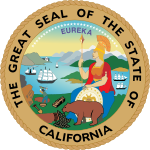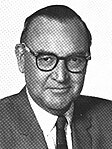
Edmund Gerald "Pat" Brown was an American lawyer and politician who served as the 32nd governor of California from 1959 to 1967. His first elected office was as district attorney for San Francisco, and he was later elected Attorney General of California in 1950, before becoming the state's governor after the 1958 California gubernatorial election.

Goodwin Jess "Goodie" Knight was an American politician and judge who served as the 31st governor of California from 1953 to 1959. A member of the Republican Party, he previously served as the 35th lieutenant governor of California from 1947 to 1953 under Governor Earl Warren.

William Fife Knowland was an American politician and newspaper publisher. A member of the Republican Party, he served as a United States Senator from California from 1945 to 1959. He was Senate Majority Leader from August 1953 to January 1955 after the death of Robert A. Taft, and would be the last Republican Senate Majority Leader until Howard Baker in 1981.

Thomas Henry Kuchel was an American politician. A moderate Republican, he served as a US Senator from California from 1953 to 1969 and was the minority whip in the Senate, where he was the co-manager on the floor for the Civil Rights Act of 1964 and the Voting Rights Act of 1965. Kuchel voted in favor of the Civil Rights Acts of 1957, 1960, and 1964, as well as the 24th Amendment to the U.S. Constitution, the Voting Rights Act of 1965, and the confirmation of Thurgood Marshall to the U.S. Supreme Court, while Kuchel did not vote on the Civil Rights Act of 1968.

The 1966 United States Senate elections were elections on November 8, 1966, for the United States Senate which occurred midway through the second term of President Lyndon B. Johnson. The 33 seats of Class 2 were contested in regular elections. Special elections were also held to fill vacancies. With divisions in the Democratic base over the Vietnam War, and with the traditional mid-term advantage of the party not holding the presidency, the Republicans took three Democratic seats, thereby breaking Democrats' 2/3rds supermajority. Despite Republican gains, the balance remained overwhelmingly in favor of the Democrats, who retained a 64–36 majority. Democrats were further reduced to 63–37, following the death of Robert F. Kennedy in June 1968.

The 1966 California gubernatorial election was held on November 8, 1966. Incumbent Democratic Governor Pat Brown was defeated in his bid for re-election by Republican nominee and future President Ronald Reagan. As of the 2022 gubernatorial election, this is the last time an incumbent governor of California lost re-election, though one subsequent incumbent governor was recalled.

The 1974 California gubernatorial election took place on November 5, 1974. The primary elections occurred on June 4, 1974. Incumbent Governor and former actor Ronald Reagan was retiring after two terms. Democratic Secretary of State Jerry Brown, son of former Governor Pat Brown, defeated Republican Controller Houston I. Flournoy in the general election. This is the first election since 1958 to not feature a Republican candidate that went on to become a U.S. president. With Brown’s election, California had a Democratic Governor and two Democratic Senators for the first time since the Civil War. This is the earliest election to feature a candidate who is still alive or living today as of 2024.

The 1962 California gubernatorial election was held on November 6, 1962. The Democratic incumbent, Pat Brown, ran for re-election against former U.S. vice president and 1960 Republican presidential nominee Richard Nixon. In his concession speech the following morning, Nixon accused the media of favoring his opponent Brown, stating that it was his "last press conference" and "You won't have Nixon to kick around any more." Six years later, Nixon was elected President of the United States, and exactly ten years after this press conference he was re-elected in a landslide.

Murray M Chotiner was an American political strategist, attorney, government official, and close associate and friend of President Richard Nixon during much of the 37th President's political career. He served as campaign manager for the future president's successful runs for the United States Senate in 1950 and for the vice presidency in 1952, and managed the campaigns of other California Republicans. He was active in each of Nixon's two successful runs for the White House in low-profile positions.
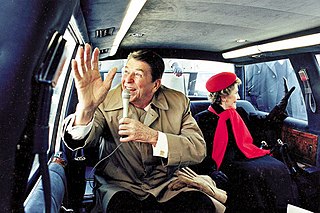
This is the electoral history of Ronald Reagan. Reagan, a Republican, served as the 40th president of the United States (1981–1989) and earlier as the 33rd governor of California (1967–1975). At 69 years, 349 days of age at the time of his first inauguration, Reagan was the oldest person to assume the presidency in the nation's history, until Donald Trump was inaugurated in 2017 at the age of 70 years, 220 days. In 1984, Reagan won re-election at the age of 73 years, 274 days, and was the oldest person to win a US presidential election until Joe Biden won the 2020 United States presidential election at the age of 77 years, 349 days.

The 1960 United States presidential election in California took place on November 8, 1960 as part of the 1960 United States presidential election. State voters chose 32 representatives, or electors, to the Electoral College, who voted for president and vice president.

The 1954California gubernatorial election was held on November 2, 1954. Incumbent Republican governor Goodwin Knight, who had ascended to the office after Earl Warren resigned to become Chief Justice of the United States the previous year, won the election to serve his sole term as Governor of California.
In American politics, cross-filing occurs when a candidate runs in the primary election of not only their own party, but also that of one or more other parties, generally in the hope of reducing or eliminating their competition at the general election. It was in effect in California from 1913 to 1959, when it was abolished, and has been used in other states, most significantly in New York and New Hampshire, where it is still in effect.

George Miller Jr. was an American Democratic politician who served as a California State Assemblyman from 1947 to 1949 and a California State Senator from 1949 to 1969. He was a leader of the liberal wing of the California Democratic Party in the early 1950s when the Republican Party dominated state government. Miller was the father of U.S. Representative George Miller III.
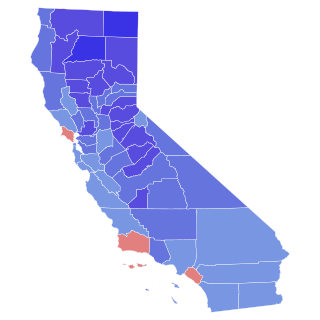
The 1958 United States Senate election in California was held on November 4, 1958.
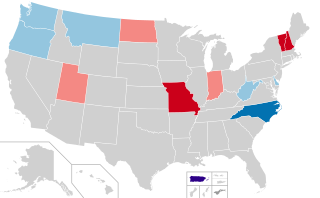
United States gubernatorial elections were held on November 8, 2016, in 12 states and two territories. The last regular gubernatorial elections for nine of the 12 states took place in 2012. The last gubernatorial elections for New Hampshire, Oregon, and Vermont took place in 2014, as Oregon held a special election due to the resignation of Governor John Kitzhaber, while the governors of New Hampshire and Vermont both serve two-year terms. The 2016 gubernatorial elections took place concurrently with several other federal, state, and local elections, including the presidential election, Senate, and House elections.

The 1954 United States Senate special election in California was held on November 2, 1954, to elect a U.S. Senator to complete the unexpired term of Senator Richard Nixon, who resigned on becoming Vice President of the United States following the 1952 presidential election. Incumbent Republican U.S. Senator Thomas Kuchel, who had been appointed by Governor Earl Warren, won election to the remainder of the term, defeating Democratic nominee Sam Yorty.

The 1964 United States Senate election in California was held on November 3, 1964.

The 1952 Tennessee gubernatorial election was held on November 4, 1952, to elect the next governor of Tennessee. Incumbent Democratic Governor, Gordon Browning was defeated in the primary by Frank G. Clement. In the general election, Clement defeated Republican nominee R. Beecher Witt with 79.4% of the vote.

The 1962 California lieutenant gubernatorial election was held on November 6, 1962. Democratic incumbent Glenn M. Anderson narrowly defeated Republican nominee George Christopher with 51.42% of the vote.

